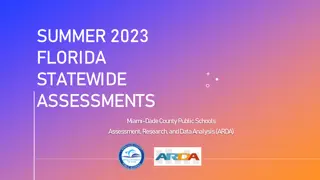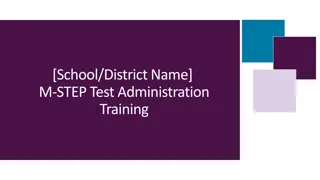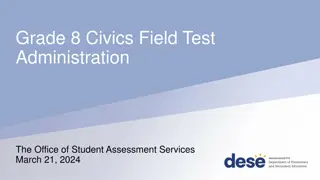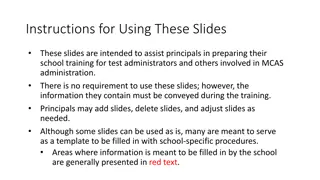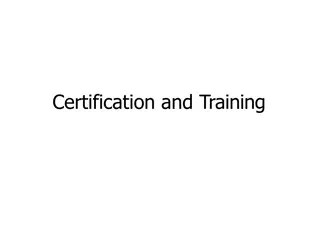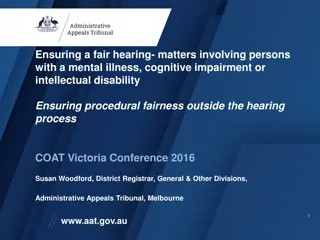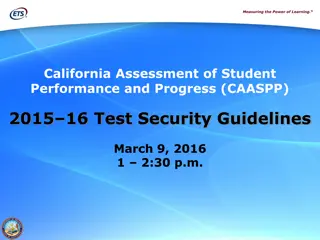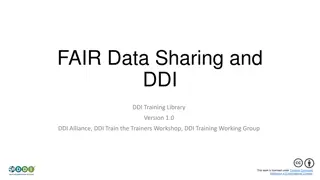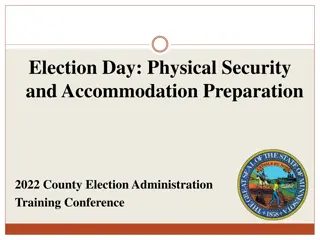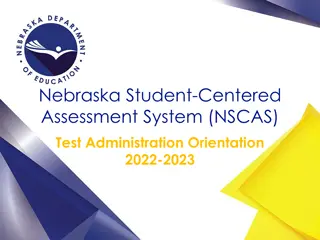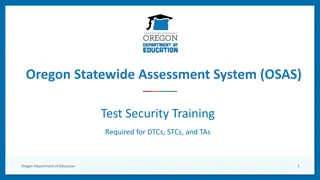Test Security Training Overview - Ensuring Fair Test Administration
Security guidelines provide a level playing field for fair test administration, ensuring valid and reliable results. Explore the importance of test security measures and their impact on student performance and test validity.
Download Presentation

Please find below an Image/Link to download the presentation.
The content on the website is provided AS IS for your information and personal use only. It may not be sold, licensed, or shared on other websites without obtaining consent from the author.If you encounter any issues during the download, it is possible that the publisher has removed the file from their server.
You are allowed to download the files provided on this website for personal or commercial use, subject to the condition that they are used lawfully. All files are the property of their respective owners.
The content on the website is provided AS IS for your information and personal use only. It may not be sold, licensed, or shared on other websites without obtaining consent from the author.
E N D
Presentation Transcript
Testing Security Winter DTC Training February 2 4, 2021 Tori Gilpin Director of Research, Evaluation & Testing Gadsden Independent School District Xavier DeLeon NAEP State Coordinator New Mexico Public Education Department Investing for tomorrow, delivering today.
Housekeeping Please remain on mute when not speaking Camera use encouraged Chat questions encouraged The meeting is being recorded Closed Captioning is available Click on this icon Then, select Show Subtitles 2
Overview Test Security training ensures that everyone knows the rules and is prepared for a fair test administration. Trainings also provides a baseline of expectations for all parties, including students Security measures are meant to equalize, protect, and standardize the school testing experience, which leads to realizable and valid results
Why Test Security Matters Security guidelines exist to provide a level playing field, without which we cannot have meaningful results. All students are to be tested under standardized conditions. Poor test security and administration practices affect the validity of the test results. It can also effect student performance and provide an advantage or disadvantage, to a student or group of students. 4 Investing for tomorrow, delivering today.
Test Security & Validity All students should have a fair chance to show what they know. All test administration and security comes down to one ultimate question: Will the test administration lead to student results that accurately reflect a valid and reliable measure of what each student knows and is able to do compared to New Mexico s academic standards? Valid and reliable testing requires the results to be accurate and meaningful. Following the test administration guidelines laid out here will help to ensure that all students have equal opportunities to show their knowledge, skills, and abilities. 5 Investing for tomorrow, delivering today.
Roles & Responsibilities for Test Security: Preparing, students, staff, facilities for testing incidents
Assessment Roles and Responsibilities Role Responsibilities include Knowing the best practices to testing Ensuring that new and returning staff receive the necessary annual training for administer PED provided tests District Test Coordinator Oversee the setup and installation of the online testing software Collaborate with DTC to ensure computers/devices are secure, operating properly, and ready for testing Technology Coordinator Passes training from DTC to building team Plans details of administering the assessment Creating rosters Plans for the use of rooms, staffing, and accommodations Ensures signage is posted (e.g., Testing, Do Not Disturb ; No Printing Copies ) School Test Coordinator Attends test security training Prepares the testing room (e.g., covers posters that could serve as cheat sheets, ensuring test booklets have been assigned to each room Check for students who need accommodations and designated supports Test Administrator Role is to support the Test Administrator Attends test security training Ensures room is secure and fully prepared Proctor May serve as a TA for another class Main responsibility is knowing the content standards that students are expected to know, and ensures instruction and curriculum are aligned Avoids drill and kill which is not in favor of deeper learning that modern assessments measure Utilizes available practice items so students are familiar with tools on the test Teacher 7 Investing for tomorrow, delivering today.
Assessment Roles and Responsibilities District Test Coordinator NMPED/Vendors School Test Coordinator DTC Test Administrator STC Proctor STC Student School Staff Primary Point of Contact for Role Training Hold a valid PED license (Teacher/Admin) Attend test security training 2x/year Must sign Confidentiality Agreement 2x/year Provide training to staff Review and know content in 6.10.7 NMAC (Filed Dec. 7, 2018) Review allowable test accommodations with staff Responsible for materials, inventory, and security Prior to Testing Provide assessment manuals and allowable support materials/tools (e.g., calculators, blank paper) Maintain local secure tracking procedures Create student and room test assignments Gives clear instructions on what is/is not allowed on each assessment Post Testing, Do Not Disturb signs Monitor halls/restroom escorts Identify students to be tested and place order During Testing Actively monitor proper and standard administration of assessments Ensure proper administration of accommodations Read the directions/scripts to students Protect student confidentiality Securely store assessment materials (including test tickets) Report irregularities as soon as possible After Testing Obtain signature on NMPED Superintendent/Principal Verification forms Ensure that all students were tested Verify student data in online portal or paper based materials Return all secure materials Securely destroy all scratch paper and test tickets Distribution of reports and post test results X X X X X X X X X X X X X X X X X X X X X X X X X X X X X X X X X X X X X X X X X X X X X *May assist a TA X X X X X X X X X X X X X X X X X X X X X X X X 8 Investing for tomorrow, delivering today.
Student Preparation All state assessments are designed to assess state aligned academic standards. Use the state content standards for curriculum development, instruction, and assessment including formative assessments, quizzes, and other evaluations for students during the instructional year. Integrate test taking skills during classroom instruction and create an environment of positive test taking. Use released documents, practice tests, and resources supported by PED. Communicate with parents and community what state assessments entail. 9 Investing for tomorrow, delivering today.
18 Prohibited Practices in 6.10.7 NMAC Using secure test questions, or altered version of Revealing, copying, or reproducing secure assessment questions, materials or student responses Repeated drilling of content identical to what is found in state assessments Example - If a school uses released items (previously used items from actual state assessments made available to the public) or similar items that are parallel to state assessment items, this should be part of an instructional program that leads to long-term learning and not to drill for the sake of attempting to artificially change test scores. Placing undue stress on a student before, during or after the test Example - Encouraging students to prepare for an upcoming test by excessive practice or studying (such as well into the evening hours) or encouraging students to work beyond a reasonable effort would be another. 10 Investing for tomorrow, delivering today.
Testing Environment Requirements Details Distraction free testing environment The school shall designate an area for the test administration that provides an environment that minimizes distractions and disruptions for students (e.g., classroom, computer lab, or library). Instructional materials removed or covered Posters, charts, visuals that might include related: content displays word lists writing formulas definitions mathematical formulas/theorems Test Administrators and Proctors must move through the room and monitor the students work area during testing; give full attention to students. The Test Administrators and Proctors should avoid distracting behaviors such as: holding extended conversations with one another reading newspapers or books eating working on a computer, using a cell phone, iPad, etc. tending to unrelated duties Active Monitoring of students 11
Testing Environment Requirements Details No student access to electronic devices Permitting students during a standardized test to have on or near their desk or on their person, any unauthorized items, including scrap paper, tablets, laptop computers, cell phones with or without cameras, cameras, calculators, calculator watches, smart watches, media players, headphones, backpacks, and rulers unless any of these are required or permitted by standardized test instructions or non-standardized accommodations request. Secure test materials All secure test materials must be kept secure at all times. Permitted room attendance Only staff involved in administering the test and the students taking the test can be in the testing room. 12
DTC Forms Retain locally; need not submit to PED
Test Irregularities: Active Monitoring before, during, and after test administration will help avoid irregularities.
Two Types of Irregularities Impactful: testing irregularities results in responses that do not accurately reflect what a student knows and can do. These tests are almost always invalidated. For example - The wrong test is started by the student, or starting a test without the proper accommodations or accessibility features in place or given the wrong accommodation based on the IEP, etc. Non-impactful: testing irregularities do not result in invalidated tests. For example - There is a technical outrage during a test, but students are able to resume testing once the signal is restored, etc. 15 Investing for tomorrow, delivering today.
Common Irregularities 2013, the federal Officer of Inspector General (OIG) released an audit of 5 state agencies: using actual test questions to prepare students for the tests erasing students wrong answers and filling in the correct answers indicating the correct answers to students during testing allowing students to change answers after giving them the correct answers allowing students to discuss answers with each other 16 Investing for tomorrow, delivering today.
Irregularities Additional Security Breaches Lost or stolen booklets Obtaining unauthorized access to secure assessment materials Logging in to view questions or change responses Teachers providing answers or providing assistance to students during testing Students accessing non-allowable resources (notes, textbooks, the internet) Taking photos of test items and sharing them on the internet or social media Accommodations being used inappropriately to cheat 17 Investing for tomorrow, delivering today.
Irregularities Cell phones or other non-allowable electronic devices Starting a test without accommodations in place Coaching/Prompting Failing to conceal visual aids in the testing room. Non-allowable accommodation Student is sick and needs to leave during the test Students talking during testing Students move past the current test session Untrained TA; TAs deviate from administration directions or script Incorrect test ticket given to student Taking test material off campus unless authorized by the DTC Unsupervised Students 18
Reporting Missing Materials The loss of secure state assessment materials is a breach of assessment security and must immediately be investigated and reported. TA must report missing materials to STC. DTC must also notify the vendor s help desk and PED. Missing test materials should be reported as an irregularity. Exception to this would be ACCESS; WIDA has their own testing materials for.m 19 Investing for tomorrow, delivering today.
Process for Reporting Testing Irregularity A testing irregularity must be: Reported to the DTC within 24 hours. Reported to PED by telephone/e-mail within 3 days. Investigated by the DTC to determine whether incident is impactful or non-impactful. Completed in the PED Test Coordinator Portal within ten days.
Flowchart: Irregularity Submission to Investigation Step 2 The PED Investigations Bureau and the Administrative Prosecutors will initiate procedures to evaluate the Complaint for investigation and potential administrative prosecution. DTCsubmits irregularity toPED AssessmentBureau Assessment Bureau reviews and determines potentialfoul play may have occured involving a licensed educator Ideally, LEA staff member, or Assessment Staff in some cases, completed the Licensure ComplaintForm. Form is submitted to Camille Malloy in Investigations Office (Camille.Maloy@state.nm.us) Step 1 Step 3 Licensure Complaint form: https://webnew.ped.state.nm.us/bureaus/general-counsel/general-counsel-documents- and-forms/
Safe/Troubled Child Alert Protocol PED AC downloads the trouble child alerts from vendor secured portal and places it in the districts SharePoint folder. PED AC calls the District Test Coordinator (DTC) and sends an email with the SharePoint URL. Vendors contact PED Assessment Coordinator (PED AC) SharePoint Troubled Child Alert Protocols DTC will report to PEDAC about the status of wellness check without needing to provide additional information. DTC notifies principal, counselor, or other personnel at the school to do a wellness check. The PED AC will contact CYFD at 1- 855-333-SAFE [7233] or #SAFE
Post Test Procedures Return all materials to the STC immediately after test session is complete. (This may vary by test schedule) Shred scrap paper. Check to be sure you have received all materials from TAs. Return all materials to the DTC once all testing sessions have been completed. Test Administrator School Test Administrator Check to be sure you have received all materials from STCs. Return all materials to the vendor prior by the deadline. (This varies by assessment). Ensure document retention for 5 years. Have the principal complete the Principal Verification Form and keep for five years. District Test Coordinator 24 Investing for tomorrow, delivering today.
Test Security Wisdom or Tips This is a sample document that can be used for Verification. We have also done online Quizzes for the STC s This idea comes from LCPS. Organization of documents is huge. We initially kept binders, now we have all documentation on Google Drive. STC s upload documents and it allows me to transfer secure student information such as test scores. Communication and ensuring that the STC s have developed relationships within their POD s. There are time s when I m simply not available to solve whatever logistical testing issue they may be having, so having a team to lean on when seeking an answer is so important. Investing for tomorrow, delivering today. Make sure STC s understand and can explain in detail the uses of these assessments 25
Using the Test Coordinator Portal: How to access and use to submit forms to the PED Adam Rios Program Coordinator New Mexico Public Education Department
Test Coordinator Portal Request new accounts at https://tcp.ped.state.nm.us/ PED approves new DTC accounts New STCs request accounts; DTCs approve DTCs approve forms created by STCs; only DTCs submit to PED Instructions at https://webnew.ped.state.nm.us/wp- content/uploads/2020/08/Test_Coordinator_Portal_Instructions_8.4.20.pdf 27 Investing for tomorrow, delivering today.
PED Assessment Portal Forms Before Testing Superintendent/Director Designation Request for Medical Exemption Request for Non-standard Assessment Accommodation During Testing Testing Irregularity Reporting Form After Testing Superintendent s Verification 28
What happens after I submit a form to the PED Portal? Irregularity Superintendent Designation PED staff review Program manager reviews PED staff approve or return Program manager completes PED section. PM approves or returns with decision. DTC receives automatic notice of DTC receives automatic notice of approval or return with PED decision and action. approval. Or DTC receives notice of return. If returned, DTC edits or completes If PM decides to invalidate score, student will not receive a score. Accountability will not include in proficiency rate calculation. and resubmits. 29 Investing for tomorrow, delivering today.
Irregularity Form PED Response 30 Investing for tomorrow, delivering today.
What do I do if the Test Coordinator Portal isnt working? Paper Forms are available on the Assessment Bureau web page: https://webnew.ped.state.nm.us/bureaus/assessment-3/district-test- coordinator/ Download Complete Sign Email the completed form to ped.assessment@state.nm.us. 31
Questions? Questions for PED?



